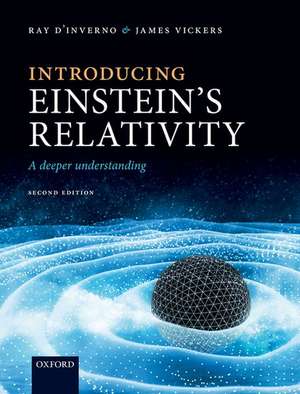Introducing Einstein's Relativity: A Deeper Understanding
Autor Ray D'Inverno, James Vickersen Limba Engleză Paperback – 7 iun 2022
| Toate formatele și edițiile | Preț | Express |
|---|---|---|
| Paperback (1) | 359.79 lei 10-16 zile | +78.82 lei 7-11 zile |
| OUP OXFORD – 7 iun 2022 | 359.79 lei 10-16 zile | +78.82 lei 7-11 zile |
| Hardback (1) | 586.66 lei 10-16 zile | |
| OUP OXFORD – 7 iun 2022 | 586.66 lei 10-16 zile |
Preț: 359.79 lei
Preț vechi: 381.23 lei
-6% Nou
Puncte Express: 540
Preț estimativ în valută:
68.85€ • 72.21$ • 57.31£
68.85€ • 72.21$ • 57.31£
Carte disponibilă
Livrare economică 28 februarie-06 martie
Livrare express 25 februarie-01 martie pentru 88.81 lei
Preluare comenzi: 021 569.72.76
Specificații
ISBN-13: 9780198862031
ISBN-10: 0198862032
Pagini: 624
Ilustrații: 240
Dimensiuni: 190 x 245 x 28 mm
Greutate: 1.36 kg
Ediția:2
Editura: OUP OXFORD
Colecția OUP Oxford
Locul publicării:Oxford, United Kingdom
ISBN-10: 0198862032
Pagini: 624
Ilustrații: 240
Dimensiuni: 190 x 245 x 28 mm
Greutate: 1.36 kg
Ediția:2
Editura: OUP OXFORD
Colecția OUP Oxford
Locul publicării:Oxford, United Kingdom
Notă biografică
Professor Ray d'Inverno is Emeritus Professor in General Relativity at the University of Southhampton. A pioneer in the use of computer algebra in general relativity, Professor d'Inverno developed the early system LAM (Lisp Algebraic Manipulator), which was a precursor to Sheep, the system most used to date in the study of exact solutions and their invariant classification. He also developed the 2+2 formalism for analysing the initial value problem in general relativity. The formalism has also been used to provide a possible route towards a canonical quantization programme for the theory. In addition, he worked in numerical relativity (solving Einstein's equations numerically on a computer) and with others set up the CCM (Cauchy-Characteristic Matching) approach, which is still used in this increasingly important field.James Vickers is an Emeritus Professor of Mathematics at the University of Southampton and has published extensively on general relativity. His early research was on the structure of weak singularities in relativity and more recently he has given proofs of both the Penrose and Hawking singularity theorems for low-regularity spacetimes. These show that the singularities predicted by these theorems must be accompanied by unbounded curvature. He has also worked on the asymptotic structure of space-time and used spinors to prove the positivity of the Bondi mass.
